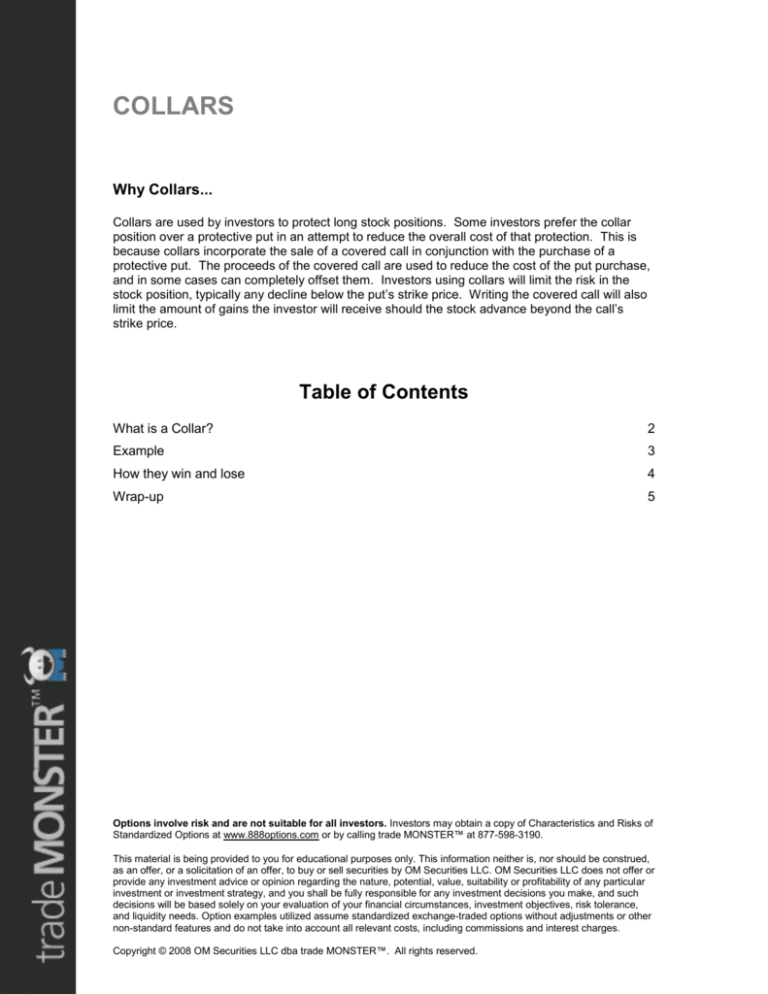
COLLARS
Why Collars...
Collars are used by investors to protect long stock positions. Some investors prefer the collar
position over a protective put in an attempt to reduce the overall cost of that protection. This is
because collars incorporate the sale of a covered call in conjunction with the purchase of a
protective put. The proceeds of the covered call are used to reduce the cost of the put purchase,
and in some cases can completely offset them. Investors using collars will limit the risk in the
stock position, typically any decline below the put’s strike price. Writing the covered call will also
limit the amount of gains the investor will receive should the stock advance beyond the call’s
strike price.
Table of Contents
What is a Collar?
2
Example
3
How they win and lose
4
Wrap-up
5
Options involve risk and are not suitable for all investors. Investors may obtain a copy of Characteristics and Risks of
Standardized Options at www.888options.com or by calling trade MONSTER™ at 877-598-3190.
This material is being provided to you for educational purposes only. This information neither is, nor should be construed,
as an offer, or a solicitation of an offer, to buy or sell securities by OM Securities LLC. OM Securities LLC does not offer or
provide any investment advice or opinion regarding the nature, potential, value, suitability or profitability of any particular
investment or investment strategy, and you shall be fully responsible for any investment decisions you make, and such
decisions will be based solely on your evaluation of your financial circumstances, investment objectives, risk tolerance,
and liquidity needs. Option examples utilized assume standardized exchange-traded options without adjustments or other
non-standard features and do not take into account all relevant costs, including commissions and interest charges.
Copyright © 2008 OM Securities LLC dba trade MONSTER™. All rights reserved.
COLLARS
What is a Collar?
Implementing the strategy with stock involves buying or owning shares of a stock and then selling
one call for each 100 shares owned – that is, the call is “covered” by the stock and also buying a
put to protect the risk of loss to the downside. The income from selling the call is used to help
offset or cover the cost of a put with a strike below the current market price of the stock for
protection.
Collars may sometimes be done for no cost, or even a credit, if the premium collected from the
sale of the call equals or outweighs the cost of the put. Selling the call does create the obligation
to sell the stock if the call is assigned.
Selling a collar on a long stock position profits up to, but not beyond the strike price of the call
sold. The maximum gain is realized if the stock price is right at or above the strike price of the call
sold. At that point the full value of the sold call is retained and the stock achieves its maximum
gain. For example: A trader sells a 50 strike call for $1 with the stock at 48. They then use the
credit to buy a 46 put, also for $1. You make money with any stock gains up to 50. The most you
can make is $2 if the stock is at or above 50 at expiration.
The most the trader can lose is also $2, if the stock is anywhere below 46. The maximum loss
occurs at the strike price of the purchased put. Below that level, the put will gain a dollar in value
for each dollar the stock loses, so the absolute loss of the entire position remains constant.
This position is theoretically identical to a vertical bull spread. The profit and loss are the same,
but the amount of margin required is much larger for the collared position due to the long stock.
For this reason, the collar is usually applied to pre-existing stock position to provide downside
protection for a limited time. When considering a collar, it may also make sense to sell the stock
and buy a vertical spread to reduce the margin requirement.
Options involve risk and are not suitable for all investors. Investors may obtain a copy of Characteristics and Risks of
Standardized Options at www.888options.com or by calling trade MONSTER™ at 877-598-3190.
This material is being provided to you for educational purposes only. This information neither is, nor should be construed,
as an offer, or a solicitation of an offer, to buy or sell securities by OM Securities LLC. OM Securities LLC does not offer or
provide any investment advice or opinion regarding the nature, potential, value, suitability or profitability of any particular
investment or investment strategy, and you shall be fully responsible for any investment decisions you make, and such
decisions will be based solely on your evaluation of your financial circumstances, investment objectives, risk tolerance,
and liquidity needs. Option examples utilized assume standardized exchange-traded options without adjustments or other
non-standard features and do not take into account all relevant costs, including commissions and interest charges.
Copyright © 2008 OM Securities LLC dba trade MONSTER™. All rights reserved.
2
COLLARS
Example
Below we see the risk profile of XYZ with the stock at 184. A 200 strike call is first sold for $15
and a 170 put is purchased for $13.50. This is a bullish position, and the value of the position will
rise and fall with the stock price, but not exactly dollar for dollar.
The risk profile at expiration is shown below.
Note how the shape of the graph has changed over time. This is due to the fact that the time
value of the options diminishes over time, and at expiration, the time value is zero for both
options. The position at expiration is then characterized by the stock value and the intrinsic value
of the put and call options.
Options involve risk and are not suitable for all investors. Investors may obtain a copy of Characteristics and Risks of
Standardized Options at www.888options.com or by calling trade MONSTER™ at 877-598-3190.
This material is being provided to you for educational purposes only. This information neither is, nor should be construed,
as an offer, or a solicitation of an offer, to buy or sell securities by OM Securities LLC. OM Securities LLC does not offer or
provide any investment advice or opinion regarding the nature, potential, value, suitability or profitability of any particular
investment or investment strategy, and you shall be fully responsible for any investment decisions you make, and such
decisions will be based solely on your evaluation of your financial circumstances, investment objectives, risk tolerance,
and liquidity needs. Option examples utilized assume standardized exchange-traded options without adjustments or other
non-standard features and do not take into account all relevant costs, including commissions and interest charges.
Copyright © 2008 OM Securities LLC dba trade MONSTER™. All rights reserved.
3
COLLARS
All three of these quantities (the stock value, the intrinsic put value and the intrinsic call value) are
dependent on the stock price. The relationship is illustrated in the graph below. Note how the
graph flattens out when the stock moves above 200. This is because above 200, the strike price
of the call option, the gain in the stock is offset by the loss in the call option (recall the call was
sold). The graph also flattens out below 170. Here the loss in the stock (as the stock approaches
zero) is offset by the gain in the put. Between 170 and 200, the position varies in value with the
variations in the stock value.
The net effect is the position profits with a rise in the price of XYZ, but profits are limited up to the
200 strike, and assignment usually happens above that price. This position will profit if the stock
does not move, as we have entered the collar for a credit of $1.50. The maximum loss occurs at
170 and stays constant from there down.
How They Win and Lose
Impact of Stock Direction
The collar will perform just as the stock in the limited range between the strikes by
expiration. The upside and downside are capped at those strikes.
Impact of Volatility
Volatility has little effect on the collar, as you are both long and short an option and
therefore have little to no exposure to changes in IV.
Impact of Time Decay
Time decay, as can be seen in comparing the two graphs above, also has only a very
small effect, depending on whether the collar was put on for a credit (we benefit from time
decay) or a debit (time decay is working against us).
Options involve risk and are not suitable for all investors. Investors may obtain a copy of Characteristics and Risks of
Standardized Options at www.888options.com or by calling trade MONSTER™ at 877-598-3190.
This material is being provided to you for educational purposes only. This information neither is, nor should be construed,
as an offer, or a solicitation of an offer, to buy or sell securities by OM Securities LLC. OM Securities LLC does not offer or
provide any investment advice or opinion regarding the nature, potential, value, suitability or profitability of any particular
investment or investment strategy, and you shall be fully responsible for any investment decisions you make, and such
decisions will be based solely on your evaluation of your financial circumstances, investment objectives, risk tolerance,
and liquidity needs. Option examples utilized assume standardized exchange-traded options without adjustments or other
non-standard features and do not take into account all relevant costs, including commissions and interest charges.
Copyright © 2008 OM Securities LLC dba trade MONSTER™. All rights reserved.
4
COLLARS
Wrap-up
A collar typically involves selling calls at a higher strike and buying puts at a lower strike
when owning stock.
It is a slightly bullish to neutral strategy
It is a lower cost position than the protective put because the proceeds from the sold call help
pay in whole or in part for the cost of the put
The maximum gain and loss are known and limited
The strategy can sometimes be done for a credit, where the proceeds from the call exceed
the cost of the put
Options involve risk and are not suitable for all investors. Investors may obtain a copy of Characteristics and Risks of
Standardized Options at www.888options.com or by calling trade MONSTER™ at 877-598-3190.
This material is being provided to you for educational purposes only. This information neither is, nor should be construed,
as an offer, or a solicitation of an offer, to buy or sell securities by OM Securities LLC. OM Securities LLC does not offer or
provide any investment advice or opinion regarding the nature, potential, value, suitability or profitability of any particular
investment or investment strategy, and you shall be fully responsible for any investment decisions you make, and such
decisions will be based solely on your evaluation of your financial circumstances, investment objectives, risk tolerance,
and liquidity needs. Option examples utilized assume standardized exchange-traded options without adjustments or other
non-standard features and do not take into account all relevant costs, including commissions and interest charges.
Copyright © 2008 OM Securities LLC dba trade MONSTER™. All rights reserved.
5







![Your_Solutions_LLC_-_New_Business3[1]](http://s2.studylib.net/store/data/005544494_1-444a738d95c4d66d28ef7ef4e25c86f0-300x300.png)
